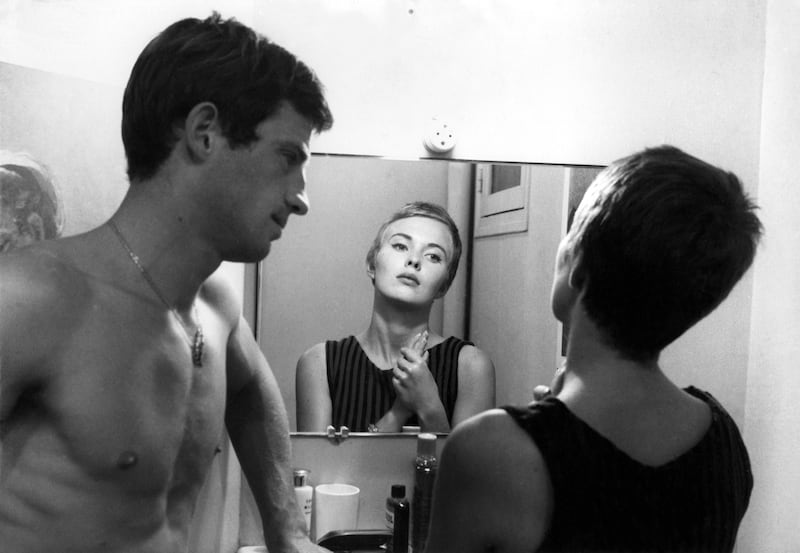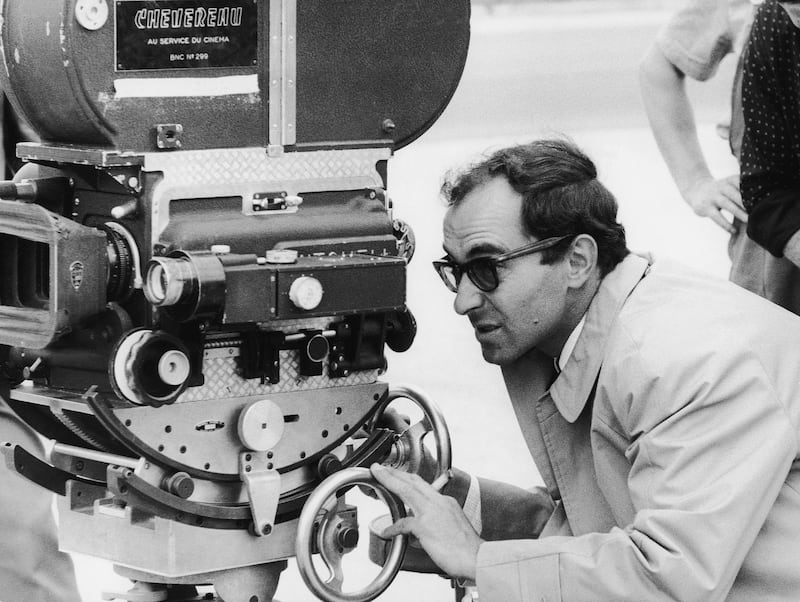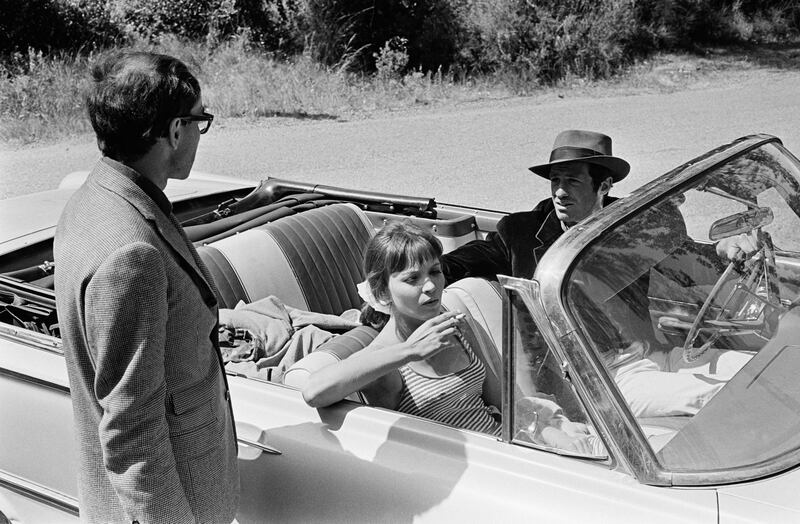Speaking years after the event, Peter Lennon recalled Jean-Luc Godard shutting down the 1967 Cannes film festival following a screening of the Irishman’s documentary Rocky Road to Dublin. “He is a perverse little guy, albeit an extremely talented one,” Lennon remarked. “He said: ‘We are speaking about revolution, and all you are talking about is close-ups and tracking shots.’ It was complete bollocks.”
Godard, who has died in his home country of Switzerland at 91, would surely have relished much of that description. A stone in the shoe for seven decades, the director lived to irritate the complacent tendency. He emerged as a critic. He developed a seat-of-the-pants cool in the early 1960s. By the end of that decade he had embraced a churning formal and political radicalism — initially Maoist but never easy to categorise — that kept critics puzzling for the rest of his life. As recently as 2014 Godard shared the Jury Prize at Cannes with the Canadian film-maker Xavier Dolan, nearly 60 years his junior, for his deafening 3-D experiment Goodbye to Language. It was as if Joyce were still around to carve up honours with Sally Rooney.
The nouvelle-vague attitude was economically evoked by the scene in Godard’s Bande à Part that finds a gang of young people racing through the Louvre at disrespectfully breakneck pace. Quentin Tarantino later named his production company A Band Apart in tribute to that film
Born in Paris, then raised largely in Switzerland as part of a wealthy Protestant family, he ended up back in the French capital as a student of anthropology and there became involved with the young critics who would later launch the upending movement known as the nouvelle vague. At ciné-clubs in the Latin Quarter he gobbled up silent cinema and developed his passion for populist American films that had hitherto evaded the attention of serious critics. His first major article, published by La Gazette du Cinéma in 1950, appeared under the title “Pour un cinéma politique”, or “Towards a political cinema”. He could hardly have better announced the coming career. “It starts from the assumption that film is, in fact, a crucial part of politics,” his biographer Colin MacCabe wrote in 2003.
In the late 1950s and early 1960s Godard and critics such as Jacques Rivette, Claude Chabrol and François Truffaut moved behind the camera to launch the nouvelle vague, or new wave. Driven both by high and by low culture, the films exhibited a looseness of approach that the previous French generation — dubbed “le cinéma de papa”, or daddy’s cinema, by Truffaut — would have regarded as unspeakably vulgar. The attitude was economically evoked by the scene in Godard’s Bande à Part, from 1964, that finds a gang of young people racing through the Louvre at disrespectfully breakneck pace. (Quentin Tarantino later named his production company A Band Apart in tribute to that film.)
Rory McIlroy’s and Tiger Woods’ teams go head to head in TGL
Soft power: the wool entrepreneurs spinning Irish yarns across the globe
Adrian Duncan: ‘I remember praying for a statue not to move because I didn’t want my world to be destroyed’
Julian Benson: ‘I got a call out of the blue in October to say there was a kidney for me’

Godard’s debut feature, Breathless, burst upon the world in 1960. From a story by Truffaut, the crime thriller — starring the rough-hewn Jean-Paul Belmondo and the ice-cool Jean Seberg — seems relatively conventional when set beside his later work, but its loosely tucked corners were radical enough to inspire a generation of coming American iconoclasts. The writers of what became Arthur Penn’s Bonnie and Clyde, the film that launched Hollywood’s postclassical period in 1967, approached Godard early on, but his plans to shoot the Texas-set crime flick in New Jersey during winter did not appeal to the producers. “I’m talking cinema and you’re talking weather. Goodbye,” he complained.
He followed Breathless with one of the great runs in world cinema. Rarely has such a highbrow sensibility melded so conveniently with contemporaneous hip. Vivre Sa Vie (1962), Alphaville (1965) and Pierrot le Fou (1965) explored issues of gender, sexuality and social responsibility in a uniquely energised style. Titles appear on screen. Characters address the camera. Brecht is ever at hand. Cinema seemed to emerge effortlessly in his wake as he passed through an increasingly fraught political environment. It is often claimed that the still thrilling Week-end marked the end of his nouvelle-vague period, but, in retrospect, that violent Marxist fable, released months after the 1967 political disturbances that led to Godard and colleagues shutting down Cannes, now points towards the director’s later, increasingly oblique attitude to his craft.

He approached John Lennon to make a film about Leon Trotsky, but the Beatle was, according to Colin McCabe, extremely suspicious. The Rolling Stones, more amenable, collaborated on the 1968 deconstruction Sympathy for the Devil. The long, long period of experimentation and provocation that followed still divides critics. Whereas Chabrol and Truffaut became something like establishment figures — the latter actually appeared in Steven Spielberg’s Close Encounters of the Third Kind — Godard continued to ignore polite convention with a cinema that provoked as much philistine ridicule as it generated cultish adoration. The final credits of Week-end read: “End of story — End of cinema.” A cynic might regard the rest of his career as mischievous, practical demonstration of that taut thesis.
Yet the arrival of a new Godard film at a major festival was always an event. I recall, on my first visit to Cannes, in 2010, queuing behind Michael Haneke — as excited as that Austrian miserabilist ever gets — for the world premiere of Film Socialisme. The director was not in attendance, but, eight years later, typically playful, Godard turned up virtually for a FaceTime press conference when The Image Book played in competition. Journalists were invited to speak into an iPhone held up by his cinematographer Fabrice Aragno. The writers seemed unsure if they had become part of the experiment. We now can now call The Image Book his last completed feature.

Married twice — to the actors Anna Karina and Anne Wiazemsky — and partner of the photographer Anne-Marie Miéville from 1979 until his death, Godard, despite his prolificity, became something of a king over the water in his later decades. He remained vital but was rarely part of the mainstream conversation. His dedicated chroniclers have divided the post–nouvelle vague career into “political films” and “transitional films” and “second wave”. His epic Histoire(s) du Cinema, created over 18 years and clocking in at 266 minutes, has taken on the quality of À la Recherche du Temps Perdu for the seventh art.
Godard earned a place in Irish history when Christians turned out to protest against domestic screenings of 1985 film Hail Mary, a work they considered blasphemous. Those events were surely an inspiration for The Passion of Saint Tibulus incident in Father Ted.
It will take decades to disentangle his vast body of work. But future film historians will keep to the task. Why would they not? Godard managed the enviable feat of remaining on the edge throughout a career of enormous length. Hyperbole is always at one’s elbow when such a figure dies, but it seems safe to say he was, until this morning, the most influential living film-maker. No obvious figure comes close to taking his place.















